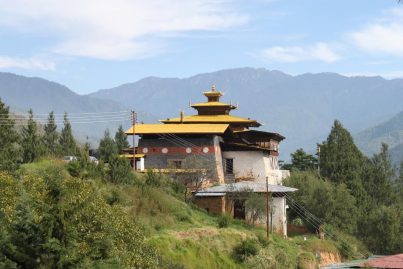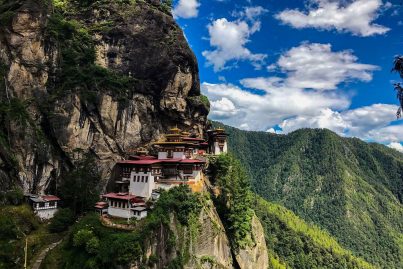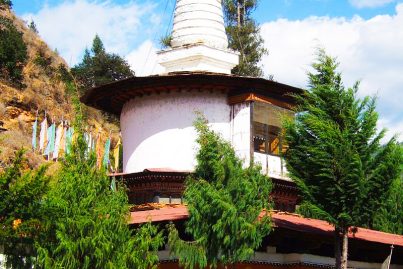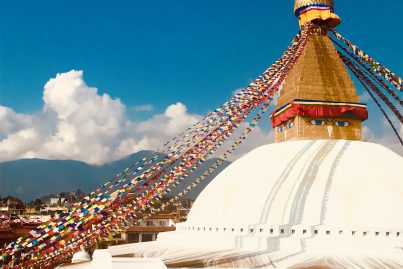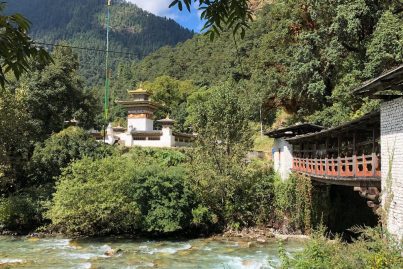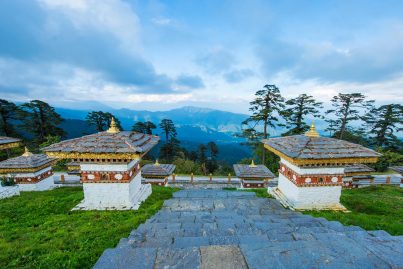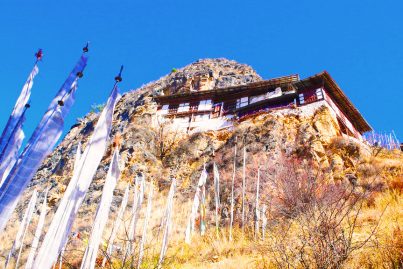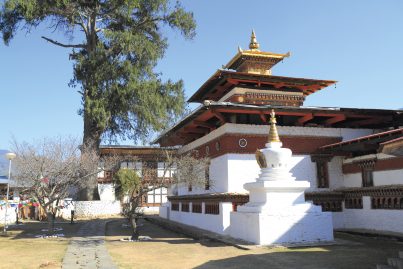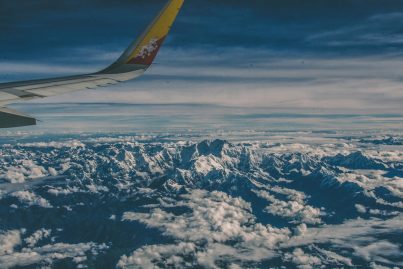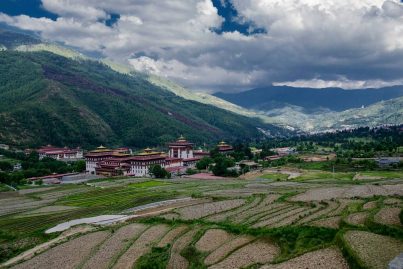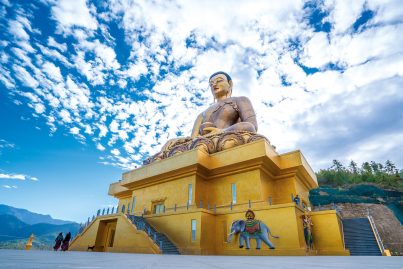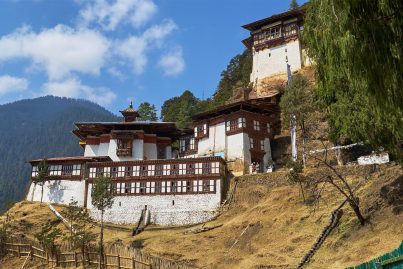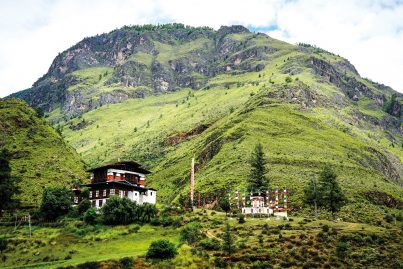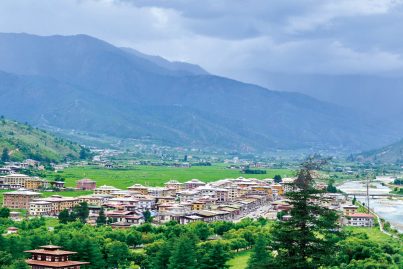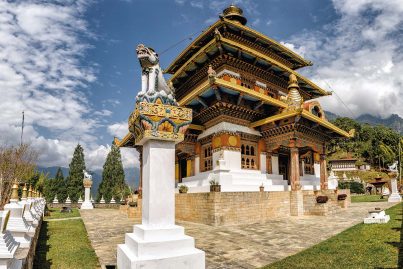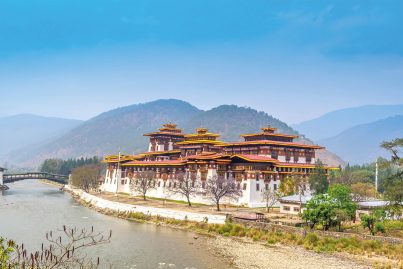TOUR OVERVIEW
The tour begins in Nepal with a visit to the famous Boudhanath Stupa before flying to Bhutan. Once we arrive in Bhutan we will begin to explore the holiest spiritual sites and important cultural monuments of Bhutan, which provide an in-depth view into the ancient way of life and rich culture that still thrives in Bhutan today. It is a well paced tour, designed to provide the opportunity to really savor the unique highlights of Bhutan’s western districts of Paro, Thimphu, and Punakha valley, which offer diverse mountainous landscapes, a rich Buddhist heritage including monasteries, temples and chortens (stupas), historical fortresses and extremely hospitable people. You will discover the vibrant history of Bhutan while visiting the Dumtse Stupa, Kyichu Monastery, and the famous Taktsang Monastery (Tiger’s Nest) in the beautiful valley of Paro. In Bhutan’s capital, Thimphu, you will visit the Dechen Phodrang Monastery before crossing the 3050m Dochula Pass from where you can see a magnificent view of the upper Himalayas and also visit the 108 stupas located there. From here you will drive into the sub-tropical Punakha valley where the incredible Punakha Dzong (Fortress) and Chimi Lhakang, temple of the ‘Divine Madman’ is located.
| Day | Activity/Valley | Overnight |
|---|---|---|
| Day 01 | Reception at Kathmandu International airport | 3-Star Hotel |
| Day 02 | Explore Katmandu | 3-Star Hotel |
| Day 03 | Fly to Bhutan, visit Kyichu Monastery upon arriving in Paro valley | 3-Star Hotel |
| Day 04 | Visit visit Kyichu Monastery and Dumtse Lhakhang | 3-Star Hotel |
| Day 05 | Hike to Chumphu Lhakhang | 3-Star Hotel |
| Day 06 | Drive to Thimphu | 3-Star Hotel |
| Day 07 | Short hike to Chagri Monastery | 3-Star Hotel |
| Day 08 | Drive towards Punakha valley, visit Chimi monastery | 3-Star Hotel |
| Day 09 | Hike to Khansum Yulley Namgyel Stupa, and later visit the Punakha Fortress | 3-Star Hotel |
| Day 10 | Visit Nobgang Village | 3-Star Hotel |
| Day 11 | Drive towards Paro valley | 3-Star Hotel |
| Day 12 | Visit Dzongdrakha Monastery | 3-Star Hotel |
| Day 13 | Hike to Tigers Nest | 3-Star Hotel |
| Day 14 | Receive Mahamudra teaching from HH Kyapgon Ngawang Tenzin Rinpoche | 3-Star Hotel |
| Day 15 | Receive Medicine Buddha empowerment from HH Kyapgon Ngawang Tenzin Rinpoche | 3-Star Hotel |
| Day 16 | Fly back to Kathmandu | 3-Star Hotel |
| Day 17 | International Departure |
Day 01 | Arrive at Kathmandu International airport
Reception at Tribhuvan International Airport
All the participants of the group will be received by our representatives at the Airport according to
your flight timing and will be transferred to the Hotel.
You will be served with dinner at the hotel and spend the night getting to know the other participants of the tour.
Hotel check-in at the Hotel Tibet International in Kathmandu, Nepal will be at 14:00
Day 02 | Visit Boudhanath stupa
Built some time around the 4th century, in the shape of a mandala designed to replicate the Gyangtse of Tibet, the stupa was renovated by Licchhavi rulers in the 8th century. The location of the stupa is interesting as it once lay on the ancient trade route to Tibet and it was here that Tibetan merchants rested and offered prayers for centuries. On each side are a pair of the all-seeing-eyes of the Buddha symbolizing awareness. At ground level there is a brick wall with 147 niches and 108 images of the meditating Buddha inset behind copper prayer wheels.
Among the Nepalese in Kathmandu, the stupa is simply referred to as “Chorten Chenpo” which translates to “Great Tower” or just “Great Stupa.”
Program of the day:
- Visit Boudhanath Stupa
- Lunch at a local restaurant
- Dinner with the group at the Hotel
Day 03 | Fly to Bhutan
Arrive at Paro International Airport
Altitude of Paro Valley – 2,250 m / 7,382 ft
Flight Details:
- Kathmandu, Nepal – Paro, Bhutan
- Baggage allowance – Checked baggage – 30 kg, and Cabin baggage – 5 kg
Program of the day:
- Reception at Paro International Airport
- Snacks will be served on the plane
- Hotel check- in
- Dinner at the hotel and briefing about the tour
Day 04 | Visit Kiychu Monastery and Dumtse Stupa
Kiychu Monastery and Dumtse Stupa
Program of the day:
- Breakfast at the Hotel
- Drive towards Kiychu Monastery,the famous 6th century monastery called the Kiychu Monastery, believed to be part of a 108 monastery that was built to subdued an evil witch by the famous Tibetan King Songtsen Gonpo,considered to be one of the holiest place in Bhutan, which has been visited and blessed by many learned and skilled Buddhist spiritual masters.
- Lunch at a local restaurant
- Visit Dumtse Lhakhang, built around the 13th century, this very peculiar temple was built in the form of a stupa by the famous Thangtong Gyalpo, or the iron bridge builder, today the temple is one of the most unique, built like a Stupa and houses a lot of intricate wall paintings.
- Take a stroll around Paro town
- Dinner at the hotel
Day 05 | Visit Drakarpo Monastery or Hike to Chumphu Lhakhang
Drakarpo Monastery
Towards the lower part of Paro, is a place, called Drakarpo. Guru Rinpoche had personally meditated in this monastery and many body prints still stands on testimony. Just below the monastery, one can see a cave where one has to pass through a narrow hole between the rocks to assess ones acts – pious or sinful. Within the cave, one can see the print of the Guru in a cave and one can see the images of a sinful and a pious person in the cave. In the cave there is the print of Paksamjoenshing. Besides all, one can see the miraculous footprint of Guru Rinpoche.
This place is considered very holy and sacred. The 8th Century revered saint, Guru Padmasambhava accompanied by his consort Dakini Yeshey Tshogay and many other Yogis and great masters down the ages have blessed and sanctified this particular place. It is also believed that if one circumambulates the mountain 108 times, even sins so great as killing one’s own parents can merit redemption. It’s quite a proclamation to say that circumambulating the mountain 108 times could merit redemption of sins so great as killing one’s own parents but doing it could very much bring about the highest level of satisfaction no matter what type of believer you are.
Program of the day:
- Breakfast at the Hotel
- Drive towards Drakarpo Monastery
- Picnic Lunch near Drakarpo Monastery
- Take a stroll around Paro town
- Dinner at the hotel
OR
Chumphu Lhakhang
Hiking distance – 5 hours walk
After breakfast we will set off early for hike to Chumphu Monastery, where the floating statue of Dorji Phamo (Vajravarahi) is situated. It is believed that Goddess Dorji Phamo flew here from Tibet and stayed on in the form of a statue. It is a life-sized statue and it is believed that the statue is floating, some people test this belief by passing a money note below her feet and it passes through smoothly without a hitch.
The Lhakhang is located under northern part of Paro. The hike begins with the opening gate (Zee Go) formed by two standing rocks. There are many rocks and caves formation associated with Guru Rinpoche and each of it has story and its significance. It is believed that before Guru Rinpoche left to subdue a demon, he spent several months in Chumphu monastery. While in Chumphu, he demonstrated several miracles such as: when he was sitting in the meditating position, he left his body and foot imprint on the cave.
The trail is a bit longer compared to hiking up Tiger’s Nest, but it is not as physically exhausting. It is a pleasant hike through an enchanting forest, following a beautiful river until you reach a Stupa (Chorten). The walk is on flat land with little gradient until the last part of the trail at a bridge located at the base of the hill. The last hundred meters incline up to the monastery is fairly steep.
The serenity of this temple is just amazing.
A typical descent from Chumphu Nye takes about 3 hours.
It takes about 1 hour drive to the base and leaving your vehicle the walk is casual and not too tiring as the hike path goes through the forest with lot of shades and cool breeze.
Program of the day:
- Breakfast at the Hotel
- Set off early for Hike to Chumphu Lhakhang
- Picnic Lunch near Chumphu Lhakhang
- Dinner at the hotel
Day 06 | Drive towards Thimphu valley
Today we will drive towards Bhutan’s capital city, Thimphu. Thimphu is the fifth highest capital city in the world by altitude; and it is also the only capital city in the world without any traffic lights. The city offers a unique blend of the modern world alongside striking Bhutanese tradition.
Altitude of Thimphu Valley – 2,320 m / 7,656 ft
Driving distance Paro to Thimphu – 2 hours (65 km)
Program of the day:
- Breakfast at the hotel
- Checkout from the hotel
- Lunch at a local restaurant
- Visit Simtokha Dzong, located on a small hill overlooking the Thimphu Valley, you will get a very great view of the Thimphu from the Dzong. This is the most oldest Dzong in Bhutan.
- Lunch at a local restaurant
- Spend time exploring Thimphu city
- Dinner at a local restaurant
Day 07 | Hike to Cheri Goempa
Altitude of Cheri Goempa – (2859 m)
Hiking Distance – 1 Hour
Cheri Goempa was established in 1620 by Zhabdrung Ngawang Namgyal, the unifier of the Bhutanese state. The monastery, which is now a major teaching and retreat center of the Southern Drukpa Lineage of the Kagyu school of Tibetan Buddhism, located at the northern end of the Thimphu Valley about 15 kilometers from the capital. It sits on a hill above Dodeyna and it takes about an hour to walk up the hill to reach the monastery.
Program of the day:
- Breakfast at the hotel
- Hike to Cheri Goempa
- Picnic Lunch by the Thimphu river side
- Take a leisure walk around Thimphu town and visit our local handicraft shops
- Dinner at a local restaurant
Day 08 | Drive towards Punakha valley and visit Chimi Lhakhang
Altitude of Punakha Valley – 1,310 m / 4,300 ft
Driving distance Thimphu to Punakha – 2 hours 30 minutes (72 km)
Chimi Lhakhang Temple:
Chimi Lhakhang Temple is about a 20 minute walk from the Lobesa highway in Punakha district. The sacred temple is also known as the “Fertility temple”. The temple was built in 1499 after the site was blessed by a saint named Drukpa Kunley (The Devine madman), a maverick Tibetan yogi who is believed to have subdued a demoness at a location near where the temple stands today. The pilgrims who visit the temple are blessed with a 10-inch wooden phallus decorated with a silver handle. Those unable to conceive children visit the temple from around the world, where the women wishing to conceive are made to carry a wooden phallus around the temple three times.
Program of the day:
- Breakfast at the hotel
- Stop en route at Dochula pass to view the stunning panoramic view of the Himalayan mountains and also visit the 108 Druk wangyal stupas that are located there.
- Lunch at Lobesa in a local restaurant
- Visit the famous Chimi Lhakhang famously known as the fertility temple.
- Hotel Check in
- Dinner at the hotel
Day 09 |Hike to Khamsum Yulley Namgyel Chorten and visit Punakha Dzong
Khamsum Yuelley Namgyel Chorten was constructed in 2004 by Her majesty the queen mother Ashi Tshering Yangden Wangchuck. It was built in accordance with the instructions of Lama Sonam Zangpo, with the intention of bringing peace in the world in general, and to clear obstacles for the country of Bhutan in particular. It’s exterior is in the form of a pagoda-like stupa while the interior consists of four stories containing images of the deities of mandalas of Vajrakilaya. Lama Kunzang Wangdi, popularly known as Lama Nyingkula, a close disciple of Dudjom Rinpoche was in charge of the construction of this Chöten. To reach Khamsum Yuelley Namgyel Chorten we need to drive for about 7 km from Punakha Dzong towards Gasa. Will park the car beside Mo chu river and then will start to hike by crossing a suspension bridge. The hike is through the rice fields of Yebisa village. It is good to hike in summer (with green rice fields) or early autumn (Golden Yellow Fields). After some time you will enter the chir pine forest and as we continue a little more will reach Khamsum Yuelley Namgyel Chorten. The hike is easy, and once you reach there you will have a good view especially from the rooftop. You will have a view of the meandering river along with interlock spurs and the beautiful villages around.
Punakha Dzong
Right at the confluence of two of Bhutan’s most important rivers (Pho chhu and Mo chhu) lies the majestic, Punakha Dzong. Punakha Dzong is a must visit, with its awe-inspiring architecture and history. From 1637-1907, Punakha served as the capital of Bhutan, where the first national assembly was hosted in 1953. Punakha dzong is also the second largest and the second oldest dzong in Bhutan. Inside the dzong, are some of the most historically important and some of the most sacred relics in the country, like the Rangjung Kharsapani and the sacred remains of Tertoen Pema Lingpa and the most important figure in Bhutan’s history, Zhabdrung Ngawang Namgyal, the Tibetan lama who unified Bhutan.
Program of the day:
- Breakfast at the hotel
- Hike to Khamsum Yulley Namgyel Chorten
- Picnic Lunch at Zamling Thang by MoChu river side
- Visit Punakha Dzong, which is the second largest and oldest fortress in Bhutan.
- Dinner at the Hotel
Day 10 |Explore Punakha valley
Visit Nobgang Monastery
Program of the day:
- Breakfast at the hotel
- Drive towards Nobgang Village and the temples located in Nobgang village. You will spend some time in the monastery.
- You will have some free time in the afternoon to relax.
- Dinner at the hotel
Day 11 | Drive back to Paro valley
Driving distance Punakha to Paro – 3 hours 30 minutes (124 km)
Program of the day:
- Breakfast at the hotel
- Lunch at a local restaurant
- Hotel check-in upon arriving Paro valley
- The evening will be at leisure to relax or do some shopping at Paro Town
- Dinner at the Hotel
Day 12 | Explore Paro valley
Visit Dzongdrakha Goempa
Program of the day:
- Breakfast at the hotel
- Visit Dzongdrakha Goempa where you will see a group of monastery overlooking the Paro Valley. The temples are situated on the cliffs above the terraced fields of village called Bondhey. The temples were built in the 16th century by the local chief, Chogay Dragpa. There are four temples, which are dedicated to Tara, Tsheringma, Guru and Jowo Jampa.
- Lunch at a local restaurant
- Explore the Paro Town
- Dinner at the Hotel
Day 13 | Loop hike to Tigers Nest
Altitude at Tigers nest – 3,120 m / 10,240 ft
Hiking distance: 4 hours hike uphill
Hike from parking base to Taktsang monastery via Zangto Pelri Monastery
Today you will hike towards the magical Taktsang Monastery popularly known as Tiger’s Nest Monastery, one of the most important religious and cultural site of Bhutan. After breakfast you will drive towards the base of Tigers, and begin our hike through the pine and rhododendron forests till you reach the Yoselgang Retreat center. We will also pass by the Ugyen pelri monastery, which is located above the actual Tiger nest monastery. A short hike down will bring you to the famous Taktsang Monastery and after visiting the many small temples and the caves you will hike down to the base from where your vehicle will pick you up and take you to your hotel.
Program of the day:
- Breakfast at the hotel
- Set off early for the hike
- Visit Yoselgang Lhakhang
- Picnic Lunch near Yoselgang Lhakhang
- Visit Tigers Nest
- Dinner at the Hotel
For people who cannot do the loop hike, they can take the straight route, which is 2.5 hours uphill hike from the base to the monastery.
Program of the day:
- Breakfast at the hotel
- Set off early for the hike to Tigers Nest
- Lunch at the cafeteria
- Dinner at the Hotel
For people who cannot do the hike at all, site seeing around the Paro valley will be arranged.
Program of the day:
- Breakfast at the hotel
- Site seeing around Paro valley
- Lunch at a local restaurant
- Dinner at the Hotel
Day 14 |Receive Medicine Buddha empowerment from HH Ngawang Tenzin Rinpoche
Receive Mahamudra teaching from HH Kyabgon Ngawang Tenzin Rinpoche
Mahamudra represents the highest level of teaching within Tibetan Buddhism. Its study and practice leads to the realization of the very nature of reality itself, there is not a single phenomenon which is not subsumed within the realizations of Mahamudra.
Program of the day:
- Breakfast at the hotel
- Teaching with HH Kyabgon Ngawang Tenzin Rinpoche
- Picnic lunch while enjoying traditional dances of Bhutan
- Dinner at a local restaurant
Day 15 |Teaching with HH Ngawang Tenzin Rinpoche
Program of the day:
- Breakfast at the hotel
- Teaching with HH Kyabgon Ngawang Tenzin Rinpoche
- Dinner at a local restaurant
Day 16 | Fly back to Kathmandu
Today we will bid fond farewell to this beautiful Himalayan Kingdom.
Flight Details:
- Paro Bhutan – Kathmandu Nepal
- Baggage allowance – Checked baggage – 30 kg, and Cabin baggage – 5 kg
Program of the day:
- Breakfast at the hotel
- Airport drop-off
- Airport pick-up from Kathmandu airport
- Hotel check-in at Hotel Tibet International in Kathmandu
- Lunch at a local restaurant
- Dinner at the hotel
Day 17 | International Departure
Wave a fond farewell as your Sangha getaway comes to an end. We hope by now you would have kept many photos and beautiful memories of Bhutan! And we look forward to seeing you again in this beautiful land of endless Enchantments.
Program of the day:
- Breakfast at the hotel
- Farewell
- Hotel check-out at the Hotel Tibet International in Kathmandu, Nepal will be at noon 12:00
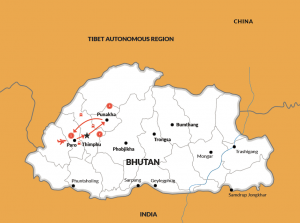
Trip Highlights:
- Visit Boudhanath stupa, which is the most sacred and liked sightseeing place in Kathmandu
- Witness spectacular bird’s eye view of the Himalayas while flying in/out from Bhutan
- Explore Bhutan’s important spiritual & pilgrimage sites
- Visit Punakha Dzong – the most beautiful monastery in Bhutan
- Hike to Taktsang Monastery ‘Tiger’s Nest’- one of the most famous monastery in Bhutan
- Receive Medicine Buddha empowerment and Mahamudra teaching from His Holiness Kyapgon Ngawang Tenzin Rinpoche
Nepal – 3 Nights | Bhutan – 13 Nights
Bhutan – Nepal tour package price per person
| For double occupancy | For single occupancy |
| USD | USD |
The above Bhutan – Nepal tour package price includes the followings:
- 3 star accommodations in Bhutan, and 4 star accommodation in Nepal
- All meals in Bhutan in designated restaurants/hotels.
- 3 times dinner in the hotel and 2 times lunch in designated restaurant, in Nepal
- Certified English speaking local tour guides in Bhutan and Nepal
- All internal ground transportation in Bhutan and Nepal, including airport pick-up and drop-off (Not including the airport drop-off in Nepal)
- Sustainable Development Fee (SDF) in Bhutan, $ 100 per night
- International Air fares (Kathmandu – Paro – Kathmandu)
- Visa fee for Bhutan
- Mineral drinking water
- All entrance fees in Bhutan and Nepal
The above Bhutan – Nepal tour package price do not include the followings:
- Other personal expenses like overseas calls, laundry, and tips for Guides and Drivers
- Travel and Medical insurance
- Visa for Nepal
- Airport drop off in Nepal. We are happy to arrange the drop-off for you upon request
- Flight to and from Kathmandu, Nepal
